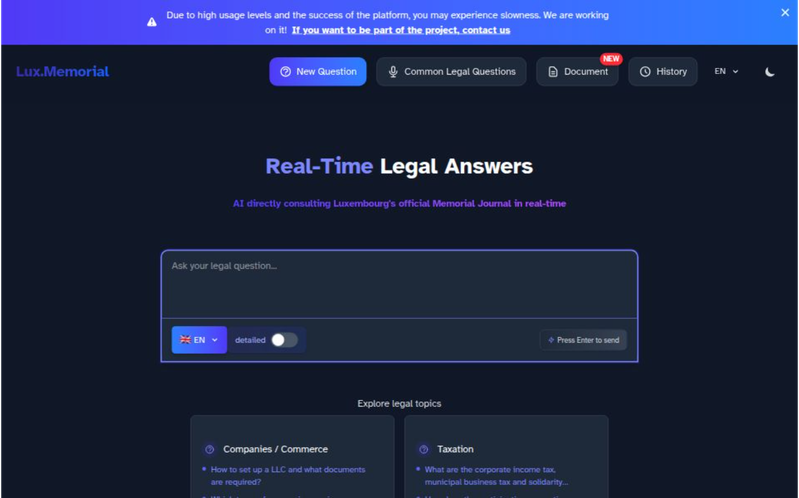
Legilux - Journal officiel du Grand-Duché de Luxembourg Legilux - Journal officiel
Description
ENGLISH VERSION
SPARQL API endpoint of the legislative database of the Grand-Duchy of Luxembourg from the website legilux.public.lu.
The semantic web project "Casemates"
The "Casemates" project of the Ministry of State - Central Legislation Service is part of a process of opening and reuse of legal data. This approach has been defined by the W3C from the perspective of the "semantic web" or "data web" (linked data). It is a question of structuring the resources so that the machines can better exploit them, but also to make them available with a license which allows their reuse by the companies, the associative world or any interested person. The project data.legilux.public.lu allows recovering and reusing both the content files and the descriptive metadata of legislation and legislative projects in Luxembourg.
The metadata are published in the semantic web language, RDF, according to two models:
- the JOLux model to describe the metadata of projects and legislation in the finest way,
- ELI model ("European Legislation Identifier"), adopted by several European countries as well as the European Union to share their legislative data in a common and interoperable format (only the metadata of the legislative texts are available according to this model, not the projects of law).
All the resources described (legislative text, legislative projects ....) have perennial identifiers in the form of URIs. URIs of legislative resources (acts, consolidations, memorials) are allocated according to the ELI standard.
Description:
SPARQL endpoint for legilux http://data.legilux.public.lu/sparql allows to freely interrogate the metadata describing the projects and the legislative texts as well as the controlled vocabularies and to recover the results in different formats including CSV, HTML, RDF ...
The SPARQL endpoint provides access to structured data in both JOLux and ELI models.
Controlled vocabularies of the luxembourgish legislation
All controlled vocabularies are made available in an interface, allowing the understanding, navigation and reuse of these lists and hierarchies.
http://data.legilux.public.lu/vocabulaires
Available vocabularies
The published vocabularies include:
- Thematic vocabularies: Themes, International Treaty Themes, Organisations (for thematic classification) and Places (for thematic classification).
- Organisations and persons: Actors/institutions, committees or persons involved in the legislative process, international actors and a history of the ministries in Luxembourg,
- Types of resources: types of legislative acts, types of treaties and types of projects and events,
- A number of technical vocabularies such as publication formats for acts, transposition statutes for EU directives, etc,
- Vocabularies from other institutions.
The raw list of vocabularies can be retrieved by this SPARQL query in Casemates.
VERSION FRANCAISE
Endpoint SPARQL de la base de données de la législation du Grand-Duché de Luxembourg, repris sur le site legilux.public.lu.
Le web sémantique dans le projet “Casemates”
Le projet “Casemates” du Ministère d’Etat - Service central de législation s'inscrit dans une démarche d'ouverture et de réutilisation des données. Cette démarche a été définie par le W3C dans la perspective du « Web sémantique » ou « Web de données » (linked data). Il s'agit de structurer les ressources pour que les machines puissent mieux les exploiter mais aussi de les mettre à disposition avec une licence qui autorise leur réutilisation par les entreprises, le monde associatif ou toute personne intéressée. Le projet data.legilux.public.lu permet de récupérer et réutiliser aussi bien les fichiers de contenu que les métadonnées descriptives de la législation et des projets législatifs du Luxembourg.
Les métadonnées sont publiées dans le langage du web sémantique, RDF, selon deux modèles:
- le modèle JOLux pour décrire les métadonnées des projets et textes législatifs de la manière la plus fine,
- le modèle ELI (“European Legislation Identifier"), adopté par plusieurs pays européens ainsi que l’Union Européenne pour partager leurs données législatives dans un format commun et interopérable (seules les métadonnées des textes législatifs sont disponibles selon ce modèle, pas les projets de loi).
Toutes les ressources décrites (texte législatif, projets législatif….) disposent d’identifiants pérennes sous forme d’URIs. Les URIs des ressources législatives (actes, consolidations, mémoriaux) sont attribuées selon le standard ELI.
Description:
Endpoint SPARQL de legilux http://data.legilux.public.lu/sparql permet d’interroger librement les métadonnées qui décrivent les projets et les textes législatifs comme les vocabulaires contrôlés et de récupérer les résultats dans différentes formats dont CSV, HTML, RDF...
Le endpoint SPARQL permet d’accéder aux données modélisées à la fois dans les modèles JOLux et ELI.
Plus d'informations disponibles sur http://legilux.public.lu/editorial/casemates
Vocabulaires contrôlés de la législation luxembourgeoise
Tous les vocabulaires contrôlés sont mis à disposition dans une interface, permettant la compréhension, la navigation et la réutilisation de ces listes et de ses hiérarchies.
http://data.legilux.public.lu/vocabulaires
Vocabulaires disponibles
Les vocabulaires publiés comprennent :
- Des vocabulaires thématiques : Thèmes, Thématiques des traités internationaux, Organisations (pour un classement thématique) et Lieux (pour un classement thématique).
- Des organisations et personnes : Les acteurs/institutions, commissions ou personnes impliqués dans le processus législatif, les acteurs internationaux et un historique des ministères du Luxembourg,
- Des types de ressources : types d'actes législatifs, types de traités et types de projets et événements,
- Un certain nombre de vocabulaires techniques comme les formats de publication des actes, les statuts de transposition des directives européennes, etc.,
- Des vocabulaires provenant d'autres institutions.
On peut récupérer la liste brute des vocabulaires par cette requête SPARQL dans Casemates.
Producer
Latest update
July 8, 2022
License
Creative Commons Attribution 4.0
Metadata quality:
Data description filled
Files documented
License filled
Update frequency followed
File formats are open
Temporal coverage not set
Spatial coverage not set
All files are available
Metadata quality
Temporal coverage not set
Spatial coverage not set
1 Reuse

There are no discussions for this dataset yet.
There are no community resources for this dataset yet.
Information
Tags
License
ID
62c83bfd9794ec8e47b5bc68
Temporality
Creation
July 8, 2022
Frequency
Real time
Latest update
July 8, 2022
